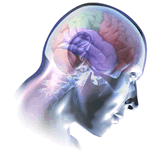Nearly
25% of People with HIV Show Signs of Neurological Problems
 |
 |
 |
 |
 |
 |
 |
| SUMMARY:
About one-quarter of HIV
positive people, and more than 40% of those
with an AIDS diagnosis, show evidence of neurological
disorders, most frequently neurocognitive impairment
and peripheral neuropathy, according to a study
published in the September
28, 2010 issue of Neurology. While specific
manifestations have changed since the advent of
effective antiretroviral therapy (ART), neurological
problems remain common and are associated with increased
risk of death. |
|
 |
 |
 |
 |
 |
 |
 |
By
Liz Highleyman
 The
occurrence of frank AIDS-related dementia has declined during
the ART era, and modern antiretroviral drugs are less likely
to cause neuropathy (nerve damage) than earlier agents such
as stavudine (d4T,
Zerit) or didanosine
(ddI, Videx). But as HIV positive people live longer,
they are prone to neurocognitive problems related to aging,
which appear to progress faster in this population. The
occurrence of frank AIDS-related dementia has declined during
the ART era, and modern antiretroviral drugs are less likely
to cause neuropathy (nerve damage) than earlier agents such
as stavudine (d4T,
Zerit) or didanosine
(ddI, Videx). But as HIV positive people live longer,
they are prone to neurocognitive problems related to aging,
which appear to progress faster in this population.
In the present study, Pornpun Vivithanaporn and Christopher
Power from the University of Alberta and colleagues looked
at the impact of combination
ART on the changing incidence (new cases) and prevalence
(total cases) of neurological disorders among people with
HIV and AIDS, as well as their effects on mortality.
The analysis included patients receiving care in a regional
HIV care program in Canada from 1998 -- as combination ART
with protease inhibitors came into widespread use -- through
2008. A total of 1651 HIV positive people were evaluated.
Most (about 80%) were men, nearly 70% were white, and the
average age was 33 years.
Results
 |
"
Of the 1651 patients assessed, 404 (24.5%) had 1 or more
neurological disorder. |
 |
Among
people with an AIDS diagnosis, the rate rose to 41.0%.
|
 |
People
with AIDS were nearly twice as likely to have neurological
problems as HIV positive people who never had an AIDS
diagnosis. |
 |
People
with lower current and nadir (lowest-ever) CD4 T-cell
counts were more likely to have neurological problems. |
 |
The
most common problems were a type of peripheral neuropathy
known as symptomatic distal sensory polyneuropathy (DSPN)
at 10.0%, and HIV-associated neurocognitive disorders
(HAND) at 6.2%. |
 |
About
half the patients with any neurological problem had 2
or more disorders. |
 |
The
incidence rate of neurological disorders dropped by half
over the course of the study, from 12.2% in 1998 to 5.7%
in 2007, mostly attributable to decreases in DSPN and
HAND. |
 |
A
total of 171 patients died during 14,134 person-years
of follow-up. |
 |
Participants
who had at least 1 neurological disorder had a significantly
higher mortality rate than people without such disorders
(17.6% vs 8.0%, respectively; P < 0.0001). |
 |
The
disparity was particularly apparent for AIDS-related deaths
(9.7% vs 3.2%, respectively; P < 0.0001). |
 |
The
highest mortality hazard ratios (HR) -- a measure of the
magnitude of increased risk of death -- were associated
with: |
 |
Opportunistic infections of the central nervous
system: HR 5.3, or about 5-fold greater risk of
death; |
 |
HIV-associated
neurocognitive disorders: HR 3.1, or about 3 times
greater mortality; |
 |
Presence
of any neurological disorders: HR 2.0, or twice
the risk. |
|
 |
Among
people with neurological disorders, the risk of AIDS-related
death increased according to viral load and CD4 cell count: |
 |
39.0%
greater risk per 10-fold increase in plasma viral
load; |
 |
13.3%
greater risk per 100 cells/mm3 reduction in CD4
count. |
|
Based
on these findings, the researchers concluded, "The burden
and type of HIV-related neurologic disease have evolved over
the past decade and despite the availability of combination
ART, neurologic disorders occur frequently and predict an
increased risk of death."
The frequency of neurological problems seen in this HIV positive
population with an average age in the mid-30s was similar
to that typically seen in HIV negative people in their mid-50s,
the study authors noted in their discussion.
A growing body of evidence indicates that chronic immune activation
and persistent inflammation associated with HIV infection
contributes to non-AIDS conditions including neurocognitive
impairment well before the CD4 cell count drops to a dangerous
level. This study supports earlier ART to keep viral load
low and CD4 count high as long as possible.
Investigator affiliations: Division of Neurology and Statistical
Consulting Centre and Department of Dentistry, University
of Alberta, Edmonton, Canada; Department of Pharmacology,
Mahidol University, Bangkok, Thailand; Southern Alberta Clinic,
Calgary, Canada; Departments of Neurology and Neuroscience,
Johns Hopkins University, Baltimore, MD; Departments of Medicine
and Medical Microbiology and Infectious Diseases, University
of Calgary, Calgary, Canada.
11/16/10
Reference
P
Vivithanaporn, G Heo, J Gamble, and others. Neurologic disease
burden in treated HIV/AIDS predicts survival: a population-based
study. Neurology 75(13): 1150-1158 (Abstract).
September 28, 2010.
|
|
|
